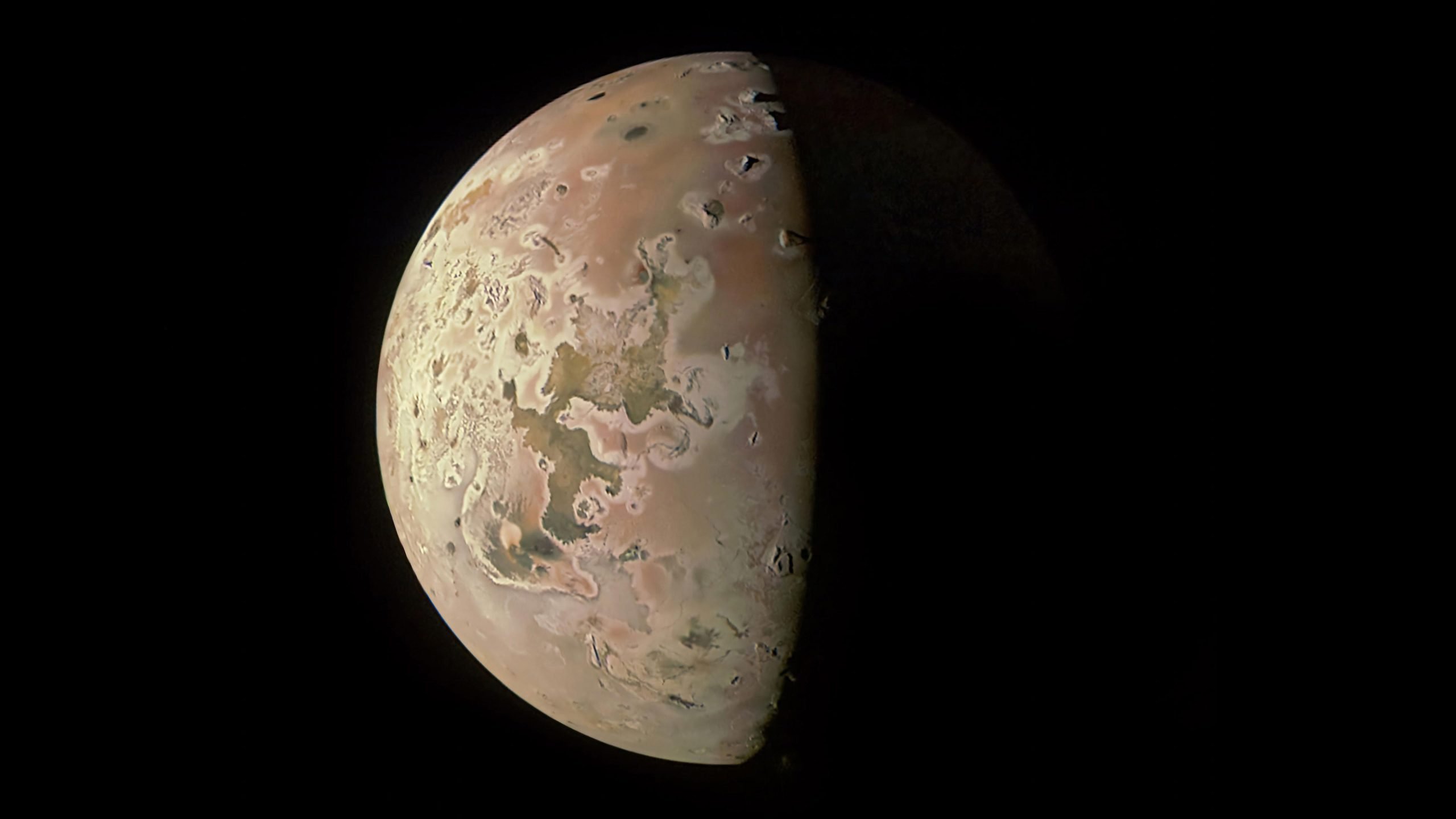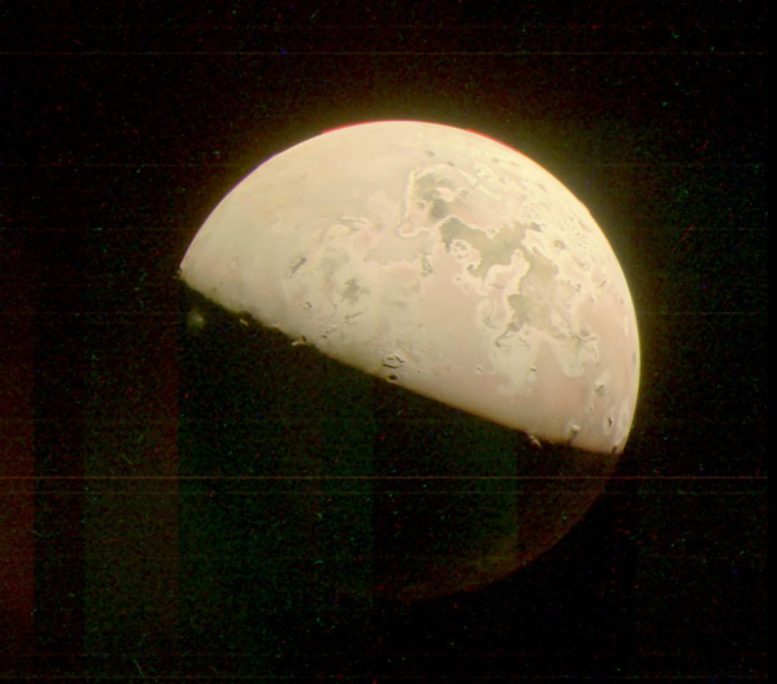
This image revealing the north polar region of the Jovian moon Io was taken on October 15 by NASA's Juno. Three of the mountain peaks visible at the top of the image, near the line dividing day and night, were observed here for the first time by the spacecraft's JunoCam camera. Image source: Image data: NASA/JPL-Caltech/SwRI/MSSS, image processing by Ted Stryk
The orbiter made 56 flybys Jupiter It documented close encounters with three of the four largest moons of the gas giant.
NASAOn Saturday, December 30, the Juno spacecraft will make its closest flyby of Jupiter's moon Io, the closest any spacecraft has achieved in more than a year. 20 years. The pass, located about 930 miles (1,500 kilometers) from the surface of our solar system's most volcanic world, is expected to allow Juno's instruments to generate a large amount of data.
“By combining data from this flyby with our previous observations, the Juno science team is studying how Io's volcanoes differ,” said Juno principal investigator Scott Bolton of the Southwest Research Institute in San Antonio, Texas. “We're looking at how often they erupt, how bright and hot they are, how the shape of the lava flow changes, and how Io's activity relates to the flow of charged particles in Jupiter's magnetosphere.”
A second very close flyby of Io is scheduled for February 3, 2024, when Juno will once again come within about 930 miles (1,500 kilometers) of the surface.
The spacecraft has been monitoring Io's volcanic activity from distances ranging from about 6,830 miles (11,000 km) to more than 62,100 miles (100,000 km), and provided the first views of the moon's north and south poles. The spacecraft also made a close flyby of Jupiter's icy moons Ganymede and Europa.

A JunoCam image of Jupiter's moon Io captures a plume of material ejected from the (unseen) Prometheus volcano. The plume is indicated by the red arrow, and is only visible in the dark below the dividing line (the line that separates day and night). The image was taken by NASA's Juno spacecraft on October 15. Image source: NASA/JPL-Caltech/SwRI/MSSS
“Through our flybys in December and February, Juno will investigate the source of Io's massive volcanic activity, whether there is a magma ocean beneath its crust, and the importance of tidal forces from Jupiter, which are relentlessly pressing on this tortured moon.” Bolton said.
Now, in the third year of its expanded mission to investigate the origin of Jupiter, the solar-powered spacecraft will also explore the ring system where some of the gas giant's inner moons are located.
Imagine this
All three cameras aboard Juno will be active during Io's flyby. Jovian infrared aurora chart (Jerram), which takes infrared images, will collect heat signatures emanating from the volcanoes and calderas covering the moon's surface. The mission's stellar reference module (a navigational stellar camera that has also provided valuable science) will have the highest-resolution image of the surface to date. The JunoCam imager will capture color images with visible light.
JunoCam is included on the spacecraft for audience participation and is designed to operate for up to eight flybys of Jupiter. Io's next flyby will be Juno's 57th orbit around Jupiter, where the spacecraft and cameras will be exposed to one of the most extreme radiation environments in the solar system.
“The cumulative effects of all this radiation have started to show up on JunoCam over the last few orbits,” said Ed Hirst, Juno project manager at NASA's Jet Propulsion Laboratory.Jet Propulsion Laboratory) in Southern California. “Images from the recent flight show a reduction in the imager's dynamic range and the appearance of 'striping' noise.” Our engineering team has been working on solutions to mitigate radiation damage and keep the imager running.
More IU, please
After several months of study and evaluation, the Juno team has modified the spacecraft's planned future trajectory to add seven new flybys of Io (18 total) to the expanded mission plan. After Io's close flyby on February 3, the spacecraft will fly around Io in every other orbit, with each orbit gradually increasing in distance: the first will be about 10,250 miles (16,500 km) above Io, and the last will be at an altitude of 10,250 miles (16,500 km). Above Io. At a distance of about 71,450 miles (115,000 km).
Io's gravitational pull on Juno during the Dec. 30 flyby will reduce the spacecraft's orbit around Jupiter from 38 days to 35 days. Juno's orbit will decrease to 33 days after the February 3 flyby.
Juno's new path will then cause Jupiter to block the sun from the spacecraft for about five minutes at a time when the orbiter is at its closest point to the planet, a period called perihelion. Although this will be the first time the solar-powered spacecraft has encountered darkness since its flyby of Earth in October 2013, the duration will be too short to affect its overall operation. Except for the February 3 period, the spacecraft will experience a solar eclipse like this during every close flyby of Jupiter from now on until the remainder of its extended mission, which ends in late 2025.
Starting in April 2024, the spacecraft will conduct a series of occultation experiments using Juno's technology. Gravity experiment To explore the composition of Jupiter's upper atmosphere, which provides key information about the planet's shape and internal structure.
More about the mission
The Jet Propulsion Laboratory (JPL), a division of the California Institute of Technology in Pasadena, California, manages the Juno mission for principal investigator Scott J. Bolton, of the Southwest Research Institute in San Antonio. Juno is part of NASA's New Frontiers Program, which is managed at NASA's Marshall Space Flight Center in Huntsville, Alabama, for the agency's Science Mission Directorate in Washington. Lockheed Martin Space in Denver built and operates the spacecraft.

“Web maven. Infuriatingly humble beer geek. Bacon fanatic. Typical creator. Music expert.”





More Stories
NASA Close to Deciding What to Do With Boeing’s Troubled Starliner Spacecraft
Scientists May Have Discovered ‘Dark Oxygen’ Created Without Photosynthesis: NPR
Real Scientists Lived on Fake Mars in a Texas Shed for a Year